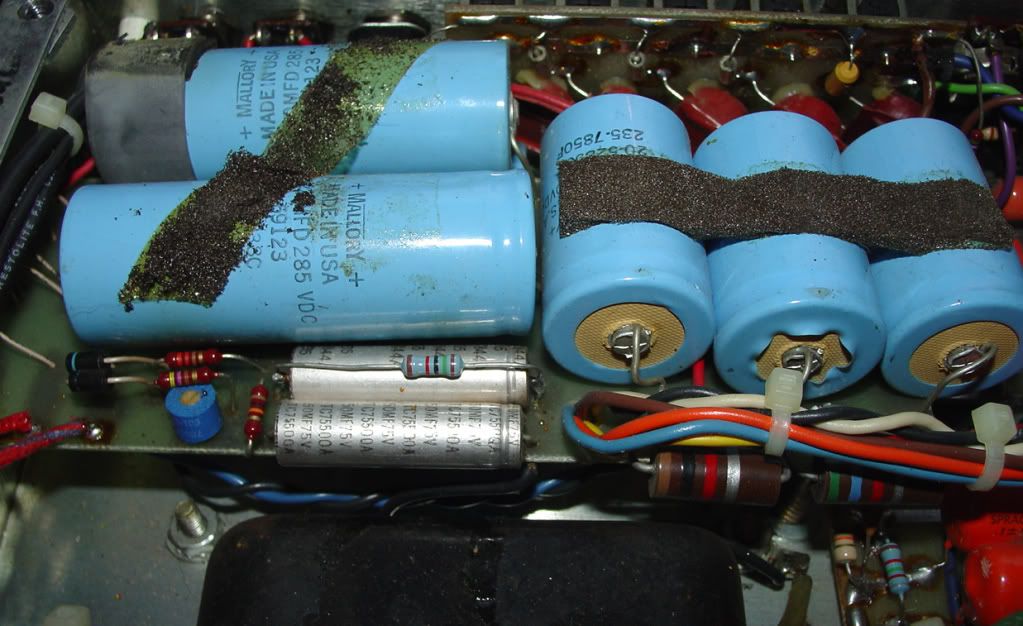Thanks for the response. I think the MKIIA's came stock with the trimpot. They were removed in the MKIIB's.
I just finished adding the trimpot to my MKIIB. Took me a couple hours, because I dropped my first attempt at the pcb, and rolled over it with my chair while trying to find it on the floor. Hate i when that happens.
I took an initial bias reading before starting. I was getting 30ma on the installed STR440 6L6 tubes. The Tung Sol's that I wanted to use, only got up to 15ma or so.
1. My MKIIB is rackmount, so opening it was just a matter of removing the 4 screws in the top. Unplugged from the power outlet before starting.
2. I then used my homemade Capacitor discharger (alligator clip to chassis > 5W 2K Resistor > old multimeter probe) to drain the caps, so I could live to write this. Checked the voltage before draining, only 10v present. After draining, they were all in the millivolt range. I watched the meter as they slowly climbed back up after removing the discharge tool. They made it all the way back up to 9v in a fairly short time, even with the amp unplugged, So I clipped the discharge tool to one of the caps and left it there while I worked.
3. Grabbed a 50K / 5w trimpot from my box o goodies, and a 2.9k / 1/2w resistor. (read in another thread that this would work). Make sure not to use a 1/4w resistor here. That's what most of us have lying around.
4. I used some needle nose pliers to squeeze legs 1 and 2 together into on leg.
5. Grabbed a piece of veroboard to make the PCB, to mount the trimpot and resistor. You don't need it, but it looks prettier, and makes for a more stable mounting. Basically, everything is running in series. Black wire > Legs 1&2 trimpot > Leg 3 > either resistor leg > other side of resistor > Yellow wire
6. Put the Black and Yellow wires into my multimeter, to verify that it worked. It did. Since I am replacing a 10k resistor, I set this trimpot arrangement to read 10k across the yellow and black wires.
7. I wanted to use some standoffs from an old computer that I had, to mount the pcb to the chassis, but I couldn't find any that would work well, so I used a double sided tape mount from my goodies box, and a tiewrap.
8. Used some 409 cleaning spray to clean an area on the chasis , so the double sided tape would stick. Not sure how this arrangement will hold up to heat, though. We'll see.
9. Placed my little homemade pcb in the clean spot.
10. Carefully bent the two resistors bridging the one that I need to get to, out of the way so I could work, then clipped one end of the 10K resistor that I am replacing. Make sure to leave enough of the 10k resistor leg, to solder the wire to.
11. I then clipped the other side of the 10k resistor and removed it.
12. Finally, I soldered the yellow and black wires from my pcb, to the legs of the previous 10k resistor. Doesn't matter which wire you solder on which leg. This is not a plus and minus situation.
I then removed my discharge tool, and powered up. Took bias readings again, and thanks to me setting the trimpot to 10k previously, my bias readings after the install were almost exactly the same as before. 31ma this time.
I checked the trimpot, and sure enough, it was working. Bias was going up and down depending on which direction i moved the trimpot screw.
Next question was Do I have enough adjustment range in the trimpot, to get the Tung-Sols up to the 30-35ma bias range? I think this particular trim pot was 20 turn, which allows for finer adjustment than a 1 turn trimpot.
Sure enough, I was able to get the Tung-Sol's up to 33ma, where I like them. I could have gone higher, but this is fine with me.
I Thought sharing this experience might be of value to anyone considering the bias mod in their MKIIb















